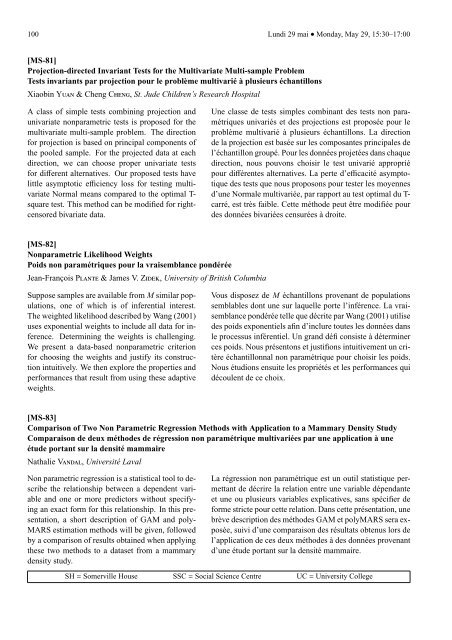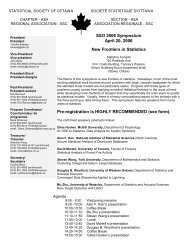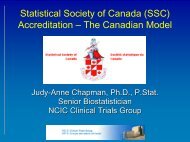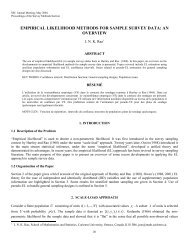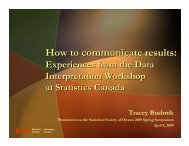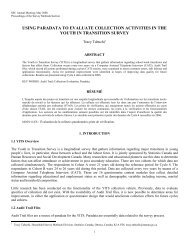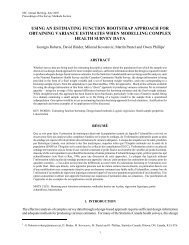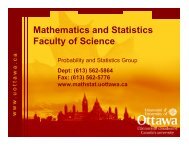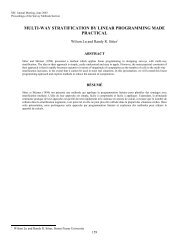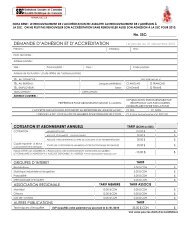Programme et résumés (pdf) - Société statistique du Canada
Programme et résumés (pdf) - Société statistique du Canada
Programme et résumés (pdf) - Société statistique du Canada
Create successful ePaper yourself
Turn your PDF publications into a flip-book with our unique Google optimized e-Paper software.
100 Lundi 29 mai • Monday, May 29, 15:30–17:00[MS-81]Projection-directed Invariant Tests for the Multivariate Multi-sample ProblemTests invariants par projection pour le problème multivarié à plusieurs échantillonsXiaobin YUAN & Cheng CHENG, St. Jude Children’s Research HospitalA class of simple tests combining projection an<strong>du</strong>nivariate nonparam<strong>et</strong>ric tests is proposed for theUne classe de tests simples combinant des tests non paramétriquesunivariés <strong>et</strong> des projections est proposée pour lemultivariate multi-sample problem. The direction problème multivarié à plusieurs échantillons. La directionfor projection is based on principal components of de la projection est basée sur les composantes principales d<strong>et</strong>he pooled sample. For the projected data at each l’échantillon groupé. Pour les données proj<strong>et</strong>ées dans chaquedirection, we can choose proper univariate tests direction, nous pouvons choisir le test univarié appropriéfor different alternatives. Our proposed tests have pour différentes alternatives. La perte d’efficacité asymptolittleasymptotic efficiency loss for testing multi- tique des tests que nous proposons pour tester les moyennesvariate Normal means compared to the optimal T- d’une Normale multivariée, par rapport au test optimal <strong>du</strong> T-square test. This m<strong>et</strong>hod can be modified for right- carré, est très faible. C<strong>et</strong>te méthode peut être modifiée pourcensored bivariate data.des données bivariées censurées à droite.[MS-82]Nonparam<strong>et</strong>ric Likelihood WeightsPoids non paramétriques pour la vraisemblance pondéréeJean-François PLANTE & James V. ZIDEK, University of British ColumbiaSuppose samples are available from M similar populations,one of which is of inferential interest.The weighted likelihood described by Wang (2001)uses exponential weights to include all data for inference.D<strong>et</strong>ermining the weights is challenging.We present a data-based nonparam<strong>et</strong>ric criterionfor choosing the weights and justify its constructionintuitively. We then explore the properties andperformances that result from using these adaptiveweights.Vous disposez de M échantillons provenant de populationssemblables dont une sur laquelle porte l’inférence. La vraisemblancepondérée telle que décrite par Wang (2001) utilisedes poids exponentiels afin d’inclure toutes les données dansle processus inférentiel. Un grand défi consiste à déterminerces poids. Nous présentons <strong>et</strong> justifions intuitivement un cri-tère échantillonnal non paramétrique pour choisir les poids.Nous étudions ensuite les propriétés <strong>et</strong> les performances quidécoulent de ce choix.[MS-83]Comparison of Two Non Param<strong>et</strong>ric Regression M<strong>et</strong>hods with Application to a Mammary Density StudyComparaison de deux méthodes de régression non paramétrique multivariées par une application à uneétude portant sur la densité mammaireNathalie VANDAL, Université LavalNon param<strong>et</strong>ric regression is a statistical tool to describ<strong>et</strong>he relationship b<strong>et</strong>ween a dependent variableand one or more predictors without specifyingan exact form for this relationship. In this presentation,a short description of GAM and poly-MARS estimation m<strong>et</strong>hods will be given, followedby a comparison of results obtained when applyingthese two m<strong>et</strong>hods to a datas<strong>et</strong> from a mammarydensity study.La régression non paramétrique est un outil <strong>statistique</strong> perm<strong>et</strong>tantde décrire la relation entre une variable dépendante<strong>et</strong> une ou plusieurs variables explicatives, sans spécifier deforme stricte pour c<strong>et</strong>te relation. Dans c<strong>et</strong>te présentation, unebrève description des méthodes GAM <strong>et</strong> polyMARS sera exposée,suivi d’une comparaison des résultats obtenus lors del’application de ces deux méthodes à des données provenantd’une étude portant sur la densité mammaire.SH = Somerville House SSC = Social Science Centre UC = University College


